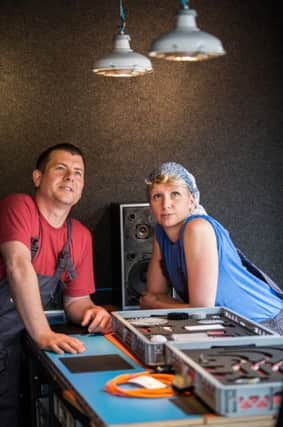Hard-wired to the past: How my failed pop career turned on a lightbulb


“We rented the third floor of an old mill in Bradford so we could live there, write songs and rehearse. It was £35 a week, dirt cheap.”
To supplement the band’s meagre income, he started quietly selling the mill’s original lighting on eBay. “The old enamel and steel reflectors were replaced by strip lights but instead of going to the expense of taking the original lighting out, the mill owners just left it in. I put a few lamps on eBay and it was obvious there was a market for them.”
Advertisement
Hide AdAdvertisement
Hide AdHe swapped Bradford for Dalston in 2006, just as the East End hit peak “cool”, but not even the location and a record deal could save Summer Holiday from obscurity. “Giving everything up to try and make a go of the band, even though it failed, gave me confidence to try something new. I was thinking about what kind of business I could launch when I remembered the factory lights. I called the mill owner and asked if I could buy the lot,” says Stanley.


He continued stripping the lighting out of other factories and selling it on eBay and he knew he was on to something when the rich, fashionable and famous began knocking on his door to collect their distressed shades. “Some really cool people were buying the lamps and designers were specifying them for cafes and restaurants,” says Stanley.
Salvage was a finite resource and extracting them from mills was dirty, unhealthy work, which is why he and his wife Sophie Gollop launched Factorylux to make new industrial-style lights that were hardwired to the past. To complement the lamps and bulb cages, they designed colourful fabric cables and sourced old-style filament bulbs, which set another trend. “We were the first people in Britain to sell the filament bulbs. I mentioned to a Swiss friend that we were trying to find some and he knew of a factory in Switzerland that still made them. We went out there and they developed a range for us. Now those filament bulbs are everywhere,” says Stanley.
The brand, whose name was inspired by Vaporlux, a paraffin light that was once made in Halifax, was an instant hit. The lamps were specified everywhere from the Levi’s store on Regent Street to Harvey Nichols while Martin Scorsese bought hundreds of filament bulbs for his movie Hugo.
Advertisement
Hide AdAdvertisement
Hide AdKeen to manufacture in Britain, the firm’s metal spinners and vitreous enamel specialists are in the Midlands and Yorkshire. The cable is from Italy as they make the best woven fabric. The business cards are made from old cereal boxes collected by local schoolchildren and are printed on a vintage Letterpress machine.


The Letterpress sits next to a Linotype machine, which Stanley rescued from the scrapyard. It now makes personalised notebooks for a small spin-off business, Prelogram. Both enterprises live under the umbrella of Urban Cottage Industries and are based in a former trouser factory, which has been modified with large areas of glazing, a biomass boiler, white paint and open-plan space. “It’s a bit of New York in Mytholmroyd,” laughs Stanley.
There are 25 staff and everyone from the MD to the people who put the lights together and pack them works side by side. “We are also employee co-owned so the staff collectively own 10 per cent of the company,” adds Stanley.
Team spirit has helped Factorylux stay ahead of those who have mercilessly copied its designs using inferior materials. “It’s annoying but you know you have to move on when they are making industrial-style lamps in China and selling them in high street shops. The shades look OK but they are painted and they chip. Our lights are like the original salvaged ones. They’ll be around for another 100 years, unlike the ones from the Far East,” says Stanley.
Advertisement
Hide AdAdvertisement
Hide AdFactorylux has an online shop but sells mainly to London-based interior designers and architects who demand quality. To service them without the need for expensive premises, it has just launched The Van, a showroom on wheels. To stay ahead of the plagiarists, it has new products, including a spotlight and copper lamps, which were never used in old factories, though they look authentic.
Another innovation is “made to order” that allows customers to pick the cord colour, shade, holder and bulb. It’s so good that top homeware store Heal’s is offering the Factorylux bespoke service in its stores from this autumn.
Back in Mytholmroyd, the team is pioneering the “next big thing”, industrial-style lighting fitted with new LED technology developed by Xicato in California. “This new LED mimics sunlight, which everyone loves, it performs consistently and it lasts for at least 25 years,” says Stanley.
“These LEDs are state of the art now but eventually every home will have them. Within 20 years lightbulbs will be obsolete. You might keep one or two for nostalgia purposes, a bit like vinyl records.”
Factorylux, www.factorylux.com
See pages 50 to 58 for our special section on transforming your home.